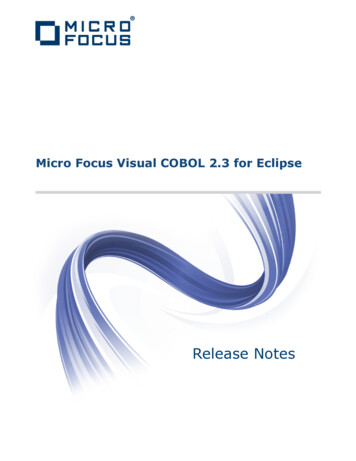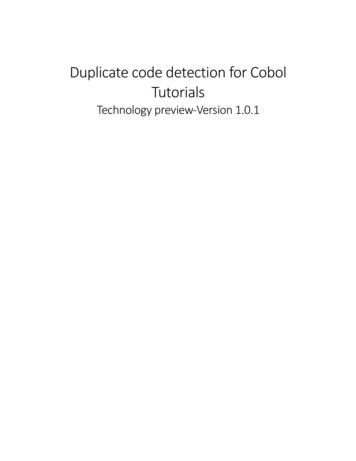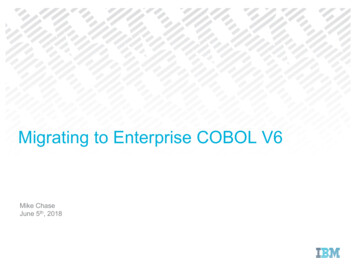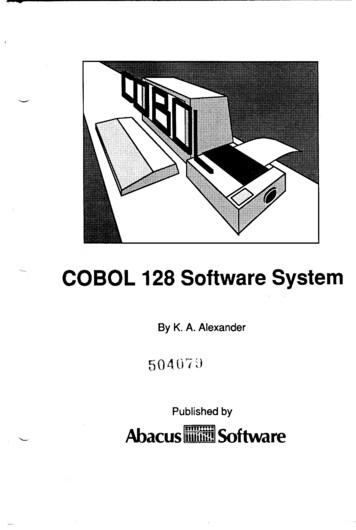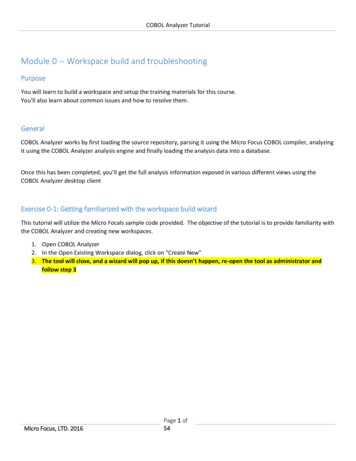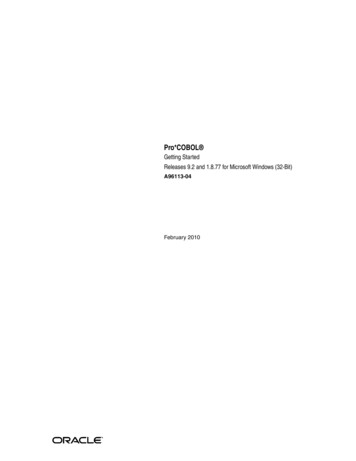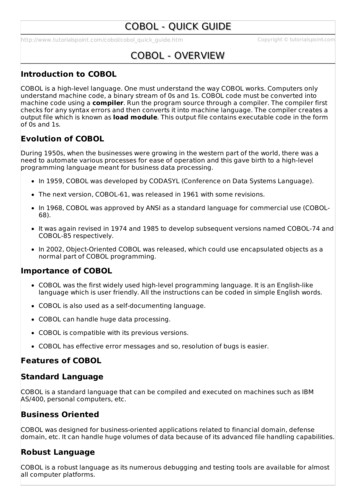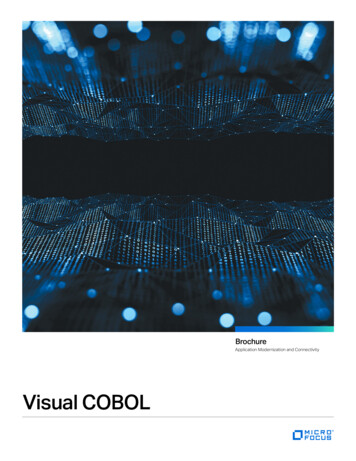
Transcription
BrochureApplication Modernization and ConnectivityVisual COBOL
BrochureVisual COBOLBusiness ChallengeThere is an increasing demand from users ofbusiness software for easier to use applications which flexibly integrate with other business systems. As a result IT organizations arebeing asked to deliver modern user interfacesand integrate multiple business systems. Atthe same time IT continually strives to reduceoperational costs and risk by standardizing oncommon platforms for all their applications.This way, the same tools and processes canbe used across teams regardless of whichprogramming language was used to build itoriginally. Microsoft’s .NET framework and theJava Virtual Machine (JVM) are widely seen asthe standard frameworks of choice.Moving to commodity hardware and managed code frameworks can return considerable cost savings and better business agility.But often, IT organizations must contend withlong-standing applications that run on agingor even unsupported hardware and softwareenvironments. Previously, IT organizations andISVs considered that their only option to delivernew innovation was to rewrite business applications in newer languages, such as Java orC#. This strategy introduces considerable costand risk for little business value. With VisualCOBOL the application’s core business logicis re-used enabling the application provider todeploy new functionality across a wide range ofenterprise platforms including Linux, .NET, JVMor the Cloud. This strategy enables the organization to take advantage of next generationtechnology alongside traditional strengths andreliability of proven application investments.IT organizations must also find ways to quick ly onboard or transfer specialty skills andresources to support existing application investments, avoiding the pitfalls of siloed application development. By standardizing withinintegrated development environments (IDEs)—Visual Studio and Eclipse, IT teams can quicklyonboard new developers already familiar with2Figure 1. Creating a REST web service using the graphical web services toolkit provided in Visual COBOLthese modern tools and processes enablingthem to take on new enterprise applicationmaintenance and development tasks. This approach accelerates onboarding, reduces newhire costs and delivers a future strategy forbuilding next generation talent.Solution OverviewVisual COBOL is a suite of software productsdesigned to meet the needs of IT organizationswith existing application investments written inthe COBOL language.Advanced COBOL application developmenttools available within Visual Studio and Eclipseprovide developers with a modern development experience, consistent with that of Javaand C# developers, facilitating fast, agile development and easy onboarding for new staff.Existing COBOL applications seamlessly integrate with C# or Java systems enabling fasterdevelopment and service delivery.Business BenefitVisual COBOL provides IT organizations withthe ability to create new customer value fromexisting application investments. By re-usingcore application logic, Visual COBOL removesthe risk associated with re-write or replacementstrategies which expose the business to uncertain cost and extended delivery time frames.With Visual COBOL, organizations can quicklyand safely respond to new business requirements and modern IT user needs with predictable and highly cost-effective results.Feature OverviewPatented Compiler TechnologyPatented compiler technology offers flexibledeployment options across native platformsincluding Windows, UNIX and Linux systemsas well as managed code environments suchas .NET and the Java Virtual Machine (JVM).The Visual COBOL compiler includes patentedtechnology that offers unique and highly versatile options for COBOL application development. COBOL programs can be compiled to avariety of executable formats including:
Intermediate code (.int) a Micro Focusplatform portable executable format Generated code (.gnt) a Micro Focusexecutable format optimized for thetarget platform Shared Object (.so) native shared objectexecutable format for UNIX/Linux platforms Windows Executable (.exe/dll) nativeWindows executable formats Java bytecode (.class) COBOL compiledto Java bytecode and executable withinthe JVM .NET Assembly (.exe/.dll) COBOL ompiled to MSIL and executable withincthe Microsoft Common LanguageRuntime (CLR).The Visual COBOL compiler offers support fora wide variety of modern and older COBOL dialect variants and includes ANSI and ISO standards, Enterprise COBOL and many others.High Performance COBOL RuntimeEnvironmentMicro Focus COBOL Server provides a highperformance and platform-portable runtimeFigure 3. Mixed language COBOL and Java development within Eclipseenvironment for the execution of COBOL applications. Consistent application behavioris provided across supported platforms andthrough use of a portable API layer, enablingdevelopers to follow a write-once, deploy-anywhere approach.COBOL Server provides many services essential to a range of COBOL applications such asfile processing, sorting and relational databasesupport. The COBOL Server also provides application tracing and diagnostic tools.The latest release of Visual COBOL includesnew compiler and runtime optimizations whichhave been shown to increase application performance on Intel-based systems by between20-30% across a broad range of benchmarks.Cross-Platform DeploymentThe Micro Focus COBOL compiler and COBOLruntime system provides ubiquitous platformcoverage enabling COBOL applications to bedeployed across a range of distributed systems, ensuring compatibility and consistentbehaviour across different platforms. Standardlibrary routines callable from COBOL applications enable application developers scope towrite-once, deploy-anywhere yet still accessoperating system level functionality.Figure 2. High performance, portable runtime execution environment for COBOL applicationswww.microfocus.com3
BrochureVisual COBOLISVs can target multiple platforms with thesame COBOL codebase, increasing marketcoverage and reducing application testingoverheads. Application owners can swiftlychange operating platforms to take advantageof commodity hardware and more agile, flexibledeployment options.This release of Visual COBOL includes support for the Docker container platform, furtherin creasing flexibility for application development and deployment. New product packaging options enable Docker deployment to bothWindows Server and Linux platforms.Advanced COBOL Development ToolsVisual COBOL extends the Visual Studio andEclipse IDEs to provide a rich COBOL development environment within the world’s mostpopular application development platforms.This release of Visual COBOL further extendsapplication development options by offering access to Visual Studio Code for COBOLdevelopment.Visual COBOL provides advanced editing anddebugging features within the IDE: Continuous background compilationcatches syntax errors as they occurproviding instant feedback to the developer Auto-complete prompts assist the eveloper when coding languagedconstructs. It automatically offerssuggestions and access to frameworkAPIs and documentation Advanced debugging tools support JIT,attach-to-process and remote debug options Multiple tool windows provide extrai nformation about the structure andlayout of the application Inline editor views provide a single windowview of a COBOL program, incorporatingall copybooks used and the result ofCOPY REPLACING Several code navigation tools assistdevelopers in identifying points of interestin the code, including go to definition,find all references, and navigation bars Snippets and templates give developersaccess to commonly used constructsand can be customized to meet specificdeveloper and development team needs Code analysis tools enable developers tocreate customizable analysis queries thatcan be executed on demand or followinga build. Out-of-the box queries identifyperformance bottlenecks and dead code.Reversible Debugging and Live RecorderThis release of Visual COBOL includes integration points to use patented reversible debugging tools from Undo.Unlike traditional debugging techniques, whichallow the developer to step forwards throughcode as it executes, reversible debugging enables a developer to step back through the application’s execution path. Somewhat akin toreviewing a CCTV recording, developers usingreversible debugging tools can retrospectivelyexamine application behavior to identify andresolve logic errors. In addition to the standard reversible debugging tools available fromwithin the Eclipse IDE, the Live Recorder utilityallows developers to capture application execution at runtime. Live Recorder trace files cansubsequently be loaded into Eclipse for debugging and diagnostic purposes. In this releaseof Visual COBOL, reversible debugging andLive Recorder tools are available for Linux x86platforms; these tools are separately licensablefrom Undo.io and can be downloaded from theMicro Focus Marketplace.Agile DevelopmentThis release of Visual COBOL includes featuresdesigned to support Agile development teams.Figure 4. Visual COBOL for Eclipse remote development option4The Micro Focus COBOL unit testing frameworkenables developers to create unit tests for newapplication code. Unit tests can be au to matedas part of a continuous integration system toprovide immediate feedback to developers on
the results of the latest checked-in code. Theunit testing framework is available within theVisual Studio and Eclipse IDEs which providetools for automatic test case creation and visualization of results.Visual COBOL includes support for commonContinuous Integration (CI) toolsets, such asMicrosoft TFS and Jenkins. Documentationguides aid in configuring CI systems to compile COBOL applications and run unit testing.CI pipelines can be augmented using additionalvalidation checks such as coding standardsrules from Micro Focus COBOL Analyzer, unittesting with code coverage, performance profiling and use of Live Recorder to capture failingtest cases.Remote Development for UNIX and LinuxProductivity offered by the Eclipse platformextends to COBOL application developmenton UNIX platforms. A remote developmentoption enables developers to use Eclipse onWindows or Linux platforms while applicationsource code and data resides on a remoteUNIX server. This feature enables teams toretain the traditional client-server approach toUNIX application development, while deliveringa unified and seamless development experience within Eclipse. Compilation and debugging occur on the remote server while beinginitiated and controlled through the Eclipse IDE.RESTful Web ServicesVisual COBOL provides several options forbuilding applications as part of an SOA or APIdevelopment strategy. Once compiled for usein .NET or JVM environments, COBOL applications can be invoked within the native framework support for web services.In addition, Visual COBOL provides a nativecode, COBOL application server which offersboth J2EE application server integration and aWeb Services option for SOAP or REST-JSONbased web services. A graphical toolset enables developers to quickly create web services from existing COBOL applications. Oncecreated, services can be debugged and deployed within the Micro Focus COBOL Serverfor SOA, a high-performance COBOL application server environment.JSONThis release of Visual COBOL includes support for generating JSON data from COBOLrecords. The JSON GENERATE verb acceptsa COBOL record structure and emits a JSONstring; the verb also provides options for renaming or suppressing certain fields. As JSONrapidly becomes the standard for data interchange and with the predominance of toolingthat can consume JSON, COBOL data in thisformat can be readily passed to external applications for processing.ContainersThe latest release of VisualCOBOL includes new compilerand runtime optimizations whichhave been shown to increaseapplication performance onIntel-based systems by between20-30% across a broad rangeof benchmarks.www.microfocus.comThe desire to deliver faster business resultshas accelerated Agile and DevOps practiceswithin IT organizations. Engineering teams areachieving higher rates of success by embracing containerized architectures to support increased software deliveries.Visual COBOL provides containerized development and deployment options using Docker.The Visual COBOL native web services toolkitsupports containerized delivery of APIs whichcan be orchestrated by Kubernetes to providescalable and reliable application delivery.UI ModernizationFor many organizations, the application user experience is often not in keeping with the needsof today’s users. Green-screen or command linedriven data entry is commonplace and an updated modern look and feel is highly desirable.Visual COBOL’s integration with .NET and JVMframeworks provide unique options for overhauling aged user interfaces while preservingexisting business logic. Modern UIs can be developed directly in COBOL or combined, usingJava, C# or VB.NET for front end functionalityand COBOL for backend service delivery.JavaVisual COBOL provides several options for creating composite applications which use bothCOBOL and Java. These include: JNI mechanisms using the Micro FocusOO COBOL Java domain Java EE using Java Connector Architecture(JCA) for EJB integration Direct bytecode generation usingCOBOL JVMThe COBOL JVM option enables COBOL ap pli cations to be directly compiled to .classfiles. This enables COBOL applications to rundirectly within the JVM and become accessibleto other JVM languages. COBOL developerscan also make use of the Java SDK or invokefunctionality implemented by other languagesin separate .class files.Microsoft .NETVisual COBOL compiler technology enablesCOBOL applications to be compiled directlyto Microsoft Intermediate Language (MSIL)assemblies. This enables COBOL applicationsto run directly within the Common LanguageRuntime (CLR) and become accessible to other5
BrochureVisual COBOL.NET languages, such as C# or VB. COBOL developers can also make use of .NET frameworkAPIs or invoke functionality implemented byother languages within separate assemblies.Modern COBOL SyntaxThe COBOL language has been enhanced tobetter support the needs of application developers working within .NET and JVM platforms.An extended and lightweight object-orientedsyntax is available for creating classes inCOBOL or can be used to invoke object-oriented code from traditional procedural COBOL.These extensions also add modern constructsto COBOL programming, such as the ability todeclare local fields.SmartLinkageWhen compiling COBOL applications for Javabytecode or MSIL, the Visual COBOL compilercan be instructed to automatically producewrapper classes which can be used by C#,VB.NET or Java developers. These classesassist other developers in calling existing procedural COBOL applications by implementingroutines that hide the complexity involved inconverting to and from COBOL systems.“Leveraging Visual COBOL wecreated a CI/CD and containerpipeline approach in AWS to giveus rapid deployment capability.Instead of two major releaseseach year, over the last 12 monthswe deployed 800 times.”MARK BELLVirtual Machine Environment—Replacement Programme Deputy DirectosDepartment for Work and Pensions6Run UnitsApplication developers and architects can facechallenges when reusing procedural COBOLapplications in multi-user environments, suchas web-based deployments in .NET and JVM.COBOL programs were traditionally architectedto isolate user state within separate processesand which conflicts with the web server modelsin .NET and JVM.Micro Focus run unit technology solves thischal lenge by enabling a top-level COBOL pro gram where all data and sub programs are thenisolated from other users of the application.Multiple instances of the top-level programcan be constructed, each corresponding toindividual users, removing the need to updateor re-architect the existing COBOL applications and easing the transition to .NET andJVM platforms.Database File HandlerFor COBOL applications using traditional filehandler data storage, Visual COBOL offersa new mechanism to automatically route filerecords into a relational database providingimproved reporting facilities using off the shelfdatabase tools and improvements to application scalability and availability.Data ToolsA comprehensive suite of COBOL data toolsis provided for the editing and maintenance ofCOBOL data files. A COBOL file editor supportsformatted data editing of COBOL data typesand a data file converter, enabling files to beconverted from one format to a wide variety ofalternatives.“When we first invested in COBOLdecades ago, who would havethought that streaming musicwould even be a thing? But herewe are, and it is testimony to thelongevity of COBOL and the strategicdirection of Micro Focus that weare successfully riding the digitaltransformation wave in our industry.”MARK ATKINSBusiness Support and Infrastructure ManagerAPRA AMCOSprocessing monitors and middleware vendorsincluding IBM TX Series and Oracle Tuxedo. Ournetwork of specialist partners, with decadesof skill in application rehosting and modernization, ensures that the most effective solutionsare provided for our customers.Specialized compiler directives are provided toemulate source platform behavior and includeplatform-specific functions, such as Little En dian (LE) routines.Data conversion tooling is available and provides support for ASCII and EBCDIC dataformats.Products Application Development V isual COBOL for Visual Studio Visual COBOL for Eclipse Visual COBOL Development HubApplication Rehosting Application DeploymentVisual COBOL is the leading choice for mainframe application rehosting projects. VisualCOBOL integrates with the leading transaction Available for use on premises or on all major COBOL Servercloud providers including AWS, Azure and GCP.
Contact us at:www.microfocus.comLike what you read? Share it.163-000005-008 M 07/22 2022 Micro Focus or one of its affiliates. Micro Focus, the Micro Focus logo, and Visual COBOL, among others,are trademarks or registered trademarks of Micro Focus or its subsidiaries or affiliated companies in the United Kingdom, United States and othercountries. All other marks are the property of their respective owners.
Visual COBOL is a suite of software products designed to meet the needs of IT organizations with existing application investments written in the COBOL language. Advanced COBOL application development tools available within Visual Studio and Eclipse provide developers with a modern develop-ment experience, consistent with that of Java
